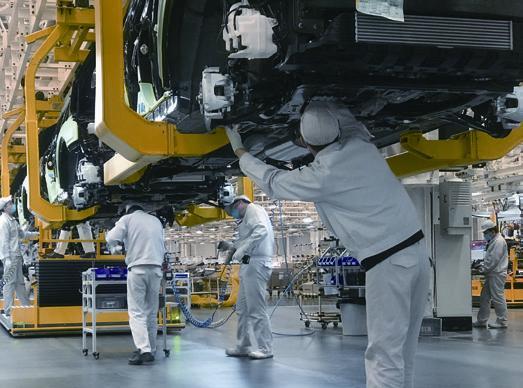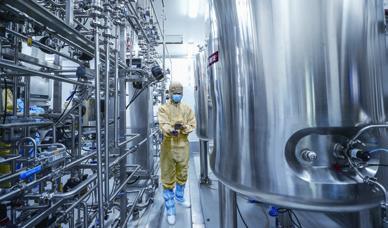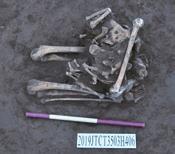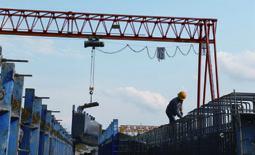STEADY RECOVERY

Staff work on the production line in a car workshop in Urumqi in Xinjiang Uygur Autonomous Region, northwest China, on April 9.
With Xinjiangs auto industry resuming work, the production of automobiles has steadily increased, and the industry in the region is on course to recovery from the adverse effects of the novel coronavirus epidemic.

Vaccine Development
The COVID-19 vaccine workshop of the China National Pharmaceutical Group (Sinopharm) on April 10. Developed by the Wuhan Institute of Biological Products under Sinopharm and the Wuhan Institute of Virology under the Chinese Academy of Sciences, the vaccine was approved for clinical trial on April 12. Another vaccine developed by Sinovac Research and Development, a company based in Beijing, was approved for trial on April 13.
COVID-19 Survey
To track asymptomatic cases of the novel coronavirus disease(COVID-19), Wuhan, the hardest-hit city in China, launched an epidemiological sample survey of local residents on April 14.
The survey started in Jiangxia District where 880 residents received free nucleic acid and antibody tests.
The survey will cover 11,000 residents in 13 districts. To ensure data accuracy, random sampling is being carried out in 100 residential communities.
Experts still need to further understand the transmission and epidemiological characteristics and pathogenic path of the novel coronavirus, explore its epidemic regularity, and improve the prevention measures, according to Ding Gangqiang, leader of the survey team sent by the Chinese Center for Disease Control and Prevention to Wuhan.
“We have launched such sample surveys in Wuhan as well as nine municipalities and provinces including Beijing, Liaoning, Shanghai and Jiangsu, to learn about peoples COVID-19 antibody level and provide a scientifi c basis for adjusting the prevention and control strategy,” Ding said.
Buddhist Murals
Cultural relic experts from across China have begun restoring murals in the Xumishan Grottoes in Ningxia Hui Autonomous Region in northwest China. The murals, dating back over 1,500 years, are a priceless example of Buddhist art.
The restoration project, started in early April, is the fi rst to save and restore Xumishan Grottoes murals since the Qing Dynasty (1644-1911), according to the Cultural Relics Management Bureau of the Xumishan Grottoes.
The grottoes, initially built in the late Northern Wei Dynasty(386-534), have 162 caves, more than 1,000 statues and 185.47 square meters of murals. They were listed as a key state-level cultural site in 1982.
The project is expected to last a year.
Improved Ecology
Ecological environment protection has progressed, with the quality of surface water and air continuing to improve in the fi rst three months of 2020, monitoring results released by the Ministry of Ecology and Environment on April 14 showed.
The ministry monitored surface water at 1,940 sampling sites and found 79.9 percent had water quality at or above Grade III, up 5.6 percentage points year on year. Water is assigned fi ve grades according to its environment quality, with Grade I denoting the best.
In the January-March period, 82.8 percent of the major rivers in China had good quality water.
During the period, the average share of days with good air quality in 337 cities was 83.5 percent, up 6.6 percentage points year on year. Nationwide, 120 cities met the air quality standards, 24 more than in the same period last year.
The average PM2.5 density in Beijing-Tianjin-Hebei and the neighboring regions went down 15.6 percent year on year, with the average share of days with good air quality rising to 59.6 percent.
Catkin Control
The Beijing Municipal Government said on April 14 that it is strengthening efforts to deal with the capitals fl ying catkins, the cotton-like seed clusters that cause discomfort and fi re hazards during spring.
Some 27,000 people and 4,000 vehicles have been mobilized to water and trim 426,000 female poplars and willows, and 100 surveillance points set up to monitor the catkins fl ying in the air, according to the Beijing Municipal Landscape and Forestry Bureau.
Due to their high survival rates, fast growth and low maintenance costs, poplars and willows were planted in Beijing in the 1960s and 1970s, when there were few tree options for landscaping.
But the fl ying catkins they produce are a nuisance for the city every spring. Even when there is no smog, Beijing residents are often seen wearing masks in April and May to avoid inhaling catkins as well as the allergy induced by them.
To reduce the impact, the municipal government has stepped up efforts to increase the diversity of landscaping trees, Jiang Yingshu, an off ciial with the bureau, said.“Poplars and willows are biologically valuable and it is impossible to simply cut down all of them. Treating catkins is a long-term issue,” Zhang Zhixiang, a professor at Beijing Forestry University, said.

Emergency Aid
A staffer of the First Hospital of China Medical University says goodbye to his colleague in Shenyang, Liaoning Province in northeast China on April 13. He was sent to Suifenhe, a city in Heilongjiang Province on the China-Russia border, which has seen a growing number of people returning from Russia and testing positive for COVID-19. The hospital sent medical equipment such as mobile X-ray machines and CT scanners, and 12 staffers including technicians and drivers to Suifenhe. The city had reported 322 confi rmed COVID-19 cases from overseas and 38 asymptomatic infections as of April 13.
Tourist Sites
Chinese authorities have released a circular saying only outdoor tourist attractions can reopen at present.
The sites that resume operation should admit no more than 30 percent of their daily visitor capacity, according to the circular from the Ministry of Culture and Tourism and the National Health Commission.
The sites should encourage visitors to make a reservation so as to control visitor fl ows and prevent large gatherings.
Some tourist attractions have seen large crowds after resuming operation, which increased the risk of virus transmission, the circular said, urging temperature checks at the entrance of major scenic spots and other tourist sites.
Captive Audience
A recent survey showed that people have watched more movies on average over the recent two months than in the same period in previous years as they spend longer hours at home amid the COVID-19 outbreak.
According to the survey of 1,530 respondents by the China Film Association and Maoyan, a leading fi lm database and ticketing platform, each respondent watched an average of six fi lms outside of cinemas in March.
Moreover, more than 70 percent of the respondents paid to watch movies online, which has increasingly become a popular option for viewers.
As the epidemic comes under control in China, more people are looking forward to watching movies at cinemas, with 34 percent saying their anticipation was very high.
Nearly 60 percent of those surveyed would be more willing to go to the cinema if proper epidemic control measures were in place and discounts were offered on tickets.
Archaeological Discovery
This undated fi le photo shows human bone remains in a kneeling position unearthed at the Chaizhuang site in Jiyuan, Henan Province in central China. The bones were found in a sacrifi cial pit dating back to the late Shang Dynasty (1600 BC-1046 BC). In the excavation since March 2019, archaeologists found a large number of late Shang Dynasty tombs, providing materials for the study of ancient social and ritual customs.

Rare Monkeys
Two Francois leaf monkey cubs, one of which is in the process of changing its fur color, were caught on camera in a nature reserve in Chongqing, southwest China.
Li Bin, a local television reporter, captured the endangered monkeys on camera earlier this month at the national nature reserve of the Jinfo Mountain.
In the video, the cub with an orange crown was trying to wriggle out of its mothers arms and climb. The other, which was entirely black, was jumping on the treetops.
Shen Ling, a senior engineer of the nature reserve administration, said the fur color of Francois leaf monkey cubs changes from orange to black while growing up.
The monkeys are usually born at the end of the winter, and March and April are a critical period for their growth.
Also known as Francois langurs, the species is one of Chinas most endangered and is on the International Union for Conservation of Nature red list. There are about 2,000 Francois leaf monkeys worldwide, of which 1,500 live in China.
IPO Issuance
China will maintain a generally steady pace in approving applications for initial public offerings(IPOs) while ensuring stable market operation, Shanghai Securities News reported on April 13.
The issuance of the IPOs will not be suspended due to any factors, nor will they be done in large batches or a centralized manner, the report said, quoting sources from authorities.
The China Securities Regulatory Commission (CSRC) has been advancing the issuance of new IPOs in a regular way since the outbreak of COVID-19, leveraging the capital markets role in supporting epidemic prevention, work resumption and development of the real economy.
Related departments are mulling rules on handling interim performance fl uctuations due to the epidemic and will enhance the capital markets resilience in forestalling risks, according to the report.
Since the beginning of the year, the CSRC has given nod to the IPO applications of 44 companies and approved the registration of 23 IPOs in the scitech innovation board.
To date, 57 companies have completed the issuance, raising a total of 82.38 billion yuan ($11.7 billion), according to the report.
Infrastructure Up
Infrastructure construction has gathered pace across China, as the government ramped up funding to spur investment in the sector following basic containment of the novel coronavirus outbreak.
Data from the China Construction Machinery Association showed excavator producers reported record sales in March as production resump- tion accelerated nationwide.
Total excavator sales, an important indicator of the vitality of an economy as demand is usually backed by growth in mining and infrastructure development, hit a record high of 49,408 in March, up 11.6 percent year on year.
The industry data, which suggested a rebound in activities, was in line with the excavator index tracked by leading construction equipment maker Sany Heavy Industry Co., Ltd. that shows infrastructure construction has recovered to the average level seen in 2019 since March 20.
In another sign of recovery, production and prices of construction materials, including cement and steel, saw visible increases. Data from the Ministry of Industry and Information Technology showed the work resumption rate of the cement industry had reached 94 percent as of April 6.
Transactions in the steel market became more active, with daily transactions reaching 238,000 tons in early April from 127,000 tons seen in early March, data from industry information provider Mysteel.com showed.
As China looks to quicken the issuance of local government bonds, which are mainly used for infrastructure, investment in the sector is likely to see double-digit growth this year.
The value of local government bonds issued in March totaled 387.5 billion yuan ($55 billion), bringing total local government bond issuance to more than 1.6 trillion yuan ($227 billion) in the fi rst quarter.

Transportation Growth
A China-Europe freight train pulls out of the Lianyungang Port at Lianyungang, Jiangsu Province in east China, on April 12. In the fi rst quarter of this year, China-Europe freight trains made 1,941 trips and transported 174,000 20-foot equivalent units of freight, up 15 percent and 18 percent year on year, respectively.
Natural Gas
A guideline on beefi ng up the infrastructure construction and storage capacity of natural gas was issued to promote the stable and sound development of the sector.
Efforts should be made to optimize construction layout and strengthen the development of standards in the sector, the document posted on the website of the National Development and Reform Commission (NDRC) on April 13 said.
It encourages existing liquefi ed natural gas (LNG) receiving stations to expand storage tanks and supports city clusters to jointly build and share storage facilities.
The guideline also called for improving operating modes and channels for return on investment in the sector and promoting the inter-connectivity and openingup of infrastructure, including LNG pipeline networks and receiving stations.
Preferential land, fi nancial, tax and investment policies will be issued to facilitate the expansion of natural gas storage capacity.
China has been promoting the effi cient use of natural gas in sectors including industrial fuel, power generation and transportation, and plans to boost the share of clean energy in its total primary energy consumption to 10 percent by 2020, according to a threeyear action plan on air pollution control released in 2018.
Online Economy
Shanghai announced on April 13 its latest action plan to promote the new online economy, which has been thriving during the COVID-19 outbreak.
According to the plan, by 2022, Shanghai is expected to have over 100 innovative online economy enterprises and launch more than 100 application scenarios, with an aim to turn itself into a development highland of the online economy with international presence.
The action plan focuses on 12 core areas, including unmanned factories, industrial Internet, remote working, online fi nance, entertainment and exhibitions, and contactless deliveries.
The plan proposes to build more than 100 unmanned factories, production lines and workshops in Shanghai and establish 20 industrial Internet platforms with national presence.
It also aims to promote unmanned deliveries in the industries involving retail, medical service and dining; encourage the application of remote consultation and surgery based on 5G technology; and further apply artifi cial intelligence in disease diagnosis and drug research and development.
Wu Jincheng, Director of the Shanghai Municipal Commission of Economy and Information Technology, said the outbreak of COVID-19 broke the original pattern of production, and the new online economy showed a booming trend.
“The action plan aims to consolidate and promote the good practices that emerged during the virus outbreak and create new momentum for economic development,” Wu said.
Flower Power
Farmers weed in a fl ower fi eld in a sub-district in Anshan, Liaoning Province in northeast China on April 13. The sub-district is a well-known fl ower cultivation base across China. Since the work resumption, local farmers have stepped up efforts to expand marketing channels and alleviate losses caused by the COVID-19 epidemic.

NEV Battery
The output of storage batteries to power new-energy vehicles(NEVs) in March surged 396.6 percent from the previous month following work resumption, industry data shows.
The output stood at 4.5 gigawatt hours, which still dropped 45.5 percent year on year due to the COVID-19 outbreak, according to the China Association of Automobile Manufacturers(CAAM).
In March, the installed capacity of the batteries stood at 2.8 gigawatt hours, surging 363.2 percent month on month, but falling 45.6 percent from the same period last year.
Chinas NEV market also saw a recovery with the output and sales climbing 381.6 percent and 301.3 percent in March over the previous month, to about 50,000 and 53,000 units, respectively.
During the fi rst quarter, Chinas NEV production and sales amounted to 105,000 units and 114,000 units, down 60.2 percent and 56.4 percent, respectively, year on year.
To promote the development of the domestic NEV market, China has been strengthening the construction of charging facilities and loosening market access requirements for NEV manufacturers. By the end of last year, the number of NEVs had reached 3.8 million.
Digital Promotion
Chinese policymakers have recently pledged to promote the transformation of enterprises toward digitalization by further expanding the application of cloud and data technologies. According to a document issued by the NDRC on April 10, efforts will be made to develop new business modes of the digital economy, foster supply chains of data and forge a digitalized whole-industrialchain ecosystem.
Vowing to equip enterprises with cloud technology, the plan, jointly issued by the NDRC and the Cyberspace Administration of China, said the country will promote digital transformation of enterprises in aspects including research and development, design, production, processing, management and sales services.
In addition, China supports platform enterprises to provide diversified services and lower costs of goods for small and medium-sized firms to help them tide over difficulties, it said.

Accelerating Construction
An employee works at the construction site of bridge beams for the Mojiang-Lincang highway in Zhenyuan Yi, Hani and Lahu Autonomous County, Yunnan Province in southwest China, on April 13. With anti-epidemic measures in place, the workers have been constructing bridge beams for the 236-km-long highway connecting Mojiang Hani Autonomous County to Lincang in the province to ensure it opens to traffi c by the end of 2020.

